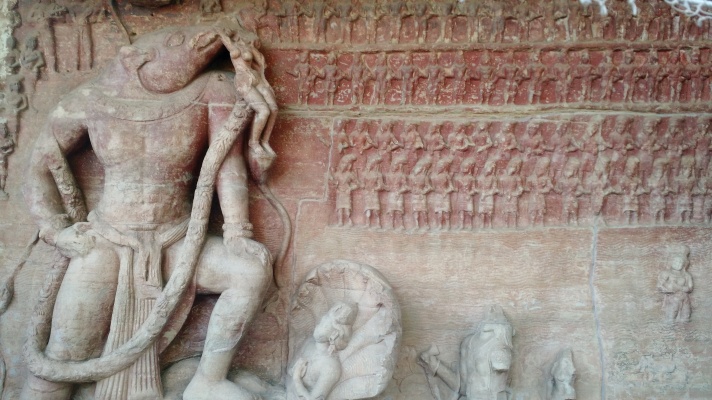
Anyone on their journey through India will definitely be touched by its rich culture and history. Sanchi takes you centuries back in time and for an Indian born in the midst of a diverse culture, the urge to visit the place where history was made is only natural.
Sanchi is located at the centre of India, near the city of Bhopal, and houses the great stupas of Buddhism- a piece of heritage that dates back to 2nd Century B.C. My journey to the place started with a hiccup. The morning of my departure was a mad rush and in that hurry, I went to the wrong station in Mumbai. I was lucky enough to get a quick ride to the right station sans the traffic but in this endeavour, I spent my last Rs. 100 note on the taxi. The only other denomination I had was a Rs. 500 note- entirely useless due to the sudden demonetisation in India. I had to survive the entire 12-hour journey to Bhopal on a bottle of water. Amidst the occasional growling of my stomach, the travel took me through some beautiful terrains and landscapes.
I reached Bhopal at around 10 in the night and found it surprisingly cold. I was shivering despite having worn two layers (temp. 15 degrees celsius). I quickly checked into my lodge, found the nearest restaurant and had two full plates of Biryani. Well, that finally answered my stomach.
Having heard a lot about Bhopal and its lakes, I decided to take a small tour around the city. With a willing auto driver as my guide, I visited two lakes and a few religious places before he dropped me back.

Early next morning, I left for Sanchi- a one-hour ride by bus. I reached my destination around 8, had a quick breakfast, got my tickets and started towards the Stupas.
Sanchi Stupas:
The monument is located on a small hill, a small climb from the base by foot or vehicle. The place by itself had a very calm and peaceful atmosphere. It was very well maintained with vast green lawns and not a single piece of trash lying around.

The Ashoka Stupa- a symbol of Buddhism and peace- was a tall dome with intricate carvings on its entrances. The place was built by Ashoka the Great, the Mauryan king who had at that time ruled a kingdom the size of India. He built this monument after he converted to Buddhism, as a symbol of peace. The pillars at the entrance had detailed carvings depicting various stories from that time.
The inner portion was relatively cooler than the outside and had a symmetric architecture which formed beautiful and unique patterns.
It took me nearly 5 hours to cover all the corners of the area. There were several temples and monasteries with a lot of sculptures and carvings, but many were in ruins.
I spent another hour in the shade of the trees, enjoying the serenity of the place. Many of the preserved artefacts were displayed in the museum at the base of the hill, where I spent my afternoon.
Udayagiri Caves
I had about 5 hours before my train back, and not wanting to waste them, I looked on for more nearby attractions. Many locals suggested Udayagiri caves. These caves are 15 km from Sanchi and there is no local transport to the place. One had to rent an auto to do so. After a lot of bargaining and convincing of Autowalas with my broken Hindi, we soon agreed upon a price.
The caves dated back to 3rd century A.D and were a patronage of Chandragupta II. It was an exhausting climb up the caves, accompanied by carvings, sculptures and engravings of old texts on the walls.

At the top of the hill, I got a breathtaking 360-degree view of the surrounding jungles, terrains and lakes. The view left me captivated for several hours.

Throughout this trip, I met a lot of interesting people – a Korean couple travelling around India, who were my company at the Stupas,

the Kushwahas family (I climbed the Udayagiri caves with them) who got me some tasty guavas from the hills, and an old-aged school teacher who travels 120km every day just to teach his children – truly inspiring. After all, what is travel without new experiences and meeting new people with inspiring tales to tell?
Editing Credits: Sharon Lewis, Pragati Jayachandran










Awesome 🙂
LikeLike
Thank you Monaj
LikeLike
The pictures are beautiful, and your post makes me Want to visit !! 🙃
LikeLike
you should visit the place its beautiful
LikeLike
Great experience needs to be shared with and I can see how much you genuinely enjoy this. A lone adventurer always has more dimensions explored in a journey. Cheers, man! 💪🏽
LikeLike
Thank you Pragati
LikeLike
Perfectly said!
LikeLike
Simply superb!
LikeLike
Thank you Srija
LikeLike
As one of the oldest stupa; housing the relics of Buddha; it’s structures built by various dynasties; containing narrative sculptures of scenes from previous lives of Buddha (Jatakas), the Sanchi stupa is a must to visit.
Good choice. I hope to visit this place when I have a chance.
LikeLike
I hope you do Yeshwanth
LikeLike
This paticular stupa reminds me of the dhyanalinga. I wonder how it is from the inside.
LikeLike
One cannot enter the stupa it is not hollow on the inside
LikeLike